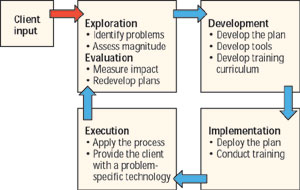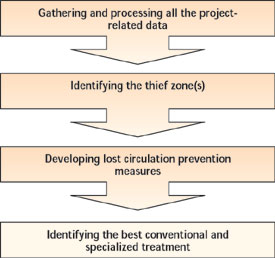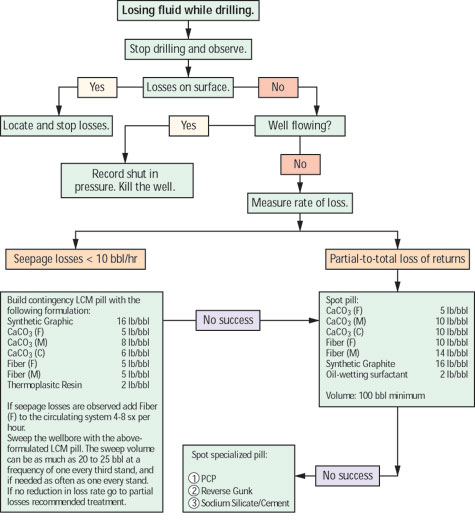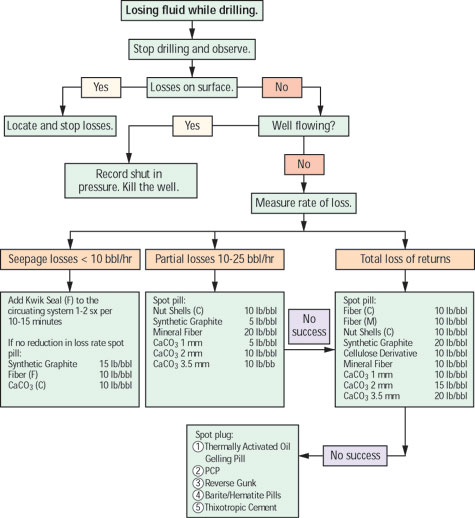Drilling & Completion Technology
Lost circulation can be managed better than ever
A new process is successfully exploring and assessing lost circulation problems, tying them to existing resources to create project-specific planning and solutions
Catalin Ivan and James Bruton, M-I, and Ben Bloys, ChevronTexaco
A methodology that explores and assesses project-specific lost circulation problems – which are subsequently linked to existing products, systems and services – is helping to prevent or dramatically minimize the tremendously costly effects of lost returns.
The uniquely structured Lost Circulation Assessment and Planning program (LCAP) has been applied successfully to prevent or minimize lost circulation (LC) in a number of loss-prone conditions, including induced fractures in the deepwater Gulf of Mexico and naturally fractured carbonates in Central Asia, among others.
Early in the drilling industry’s history, the LC problem became apparent and was magnified considerably, when operators began drilling deeper wells and/or through depleted formations. The industry spends millions of dollars annually to combat LC and the detrimental effects it propagates, such as lost rig time, stuck pipe, sidetracks, blowouts and, occasionally, abandonment of expensive wells.
It is estimated that LC costs the industry around $800 million per year, while LC products could represent as much as $200 million. Moreover, LC has even been blamed for minimized output, in that losses have resulted in failure to secure production tests and samples, while the plugging of productive zones has led to decreased productivity.
Traditionally, LC control has been reactionary. The LCAP process involves proactively exploring and assessing project-specific LC problems and linking them to existing products, systems and services, Fig. 1.
 |
Fig. 1. The Lost Circulation Assessment and Planning process explores and assesses project-specific lost circulation problems and links them to existing products, systems and services. The process uses existing resources to create project-specific plans and solutions.
|
|
The process focuses on available products (i.e., conventional LCM, specialized polymer cross-linked pills, software tools) and uses existing resources (offset well analysis, logs, mineralogy/geology analysis) to create project-specific plans and solutions. For maximum success, emphasis is placed on assessment and planning rather than individual products. This methodology prevents and minimizes lost circulation problems rather than pursuing an after-the-fact cure. Careful preplanning simplifies the process of choosing from 177 specialized LC products offered by 46 different drilling fluid suppliers.
ASSESSMENT & PLANNING: THE PROCESS
The LCAP concept explores and assesses project-specific LC problems and links them to existing products, systems and services that address the problem. The process focuses on using existing resources to create project-specific plans and solutions. There are five key elements to this continuous improvement process – exploration, development, implementation, execution and evaluation.
Exploration phase. During this phase, a multidisciplinary exploration team (operator and service company technology center specialists, service company field specialists, rig supervisors, drilling engineers, geologists, logistics personnel, formation evaluation personnel) is formed. This team identifies candidate wells for the LCAP process, assesses the potential LC magnitude, obtains offset well information, develops strategic plans, and defines the development team’s roles and responsibilities.
Development phase. A technical development team (project engineers, drilling engineers, drilling supervisors) analyzes offset well data to identify the most probable thief zones, and links existing LC products and technology with potential for solving the specific problem. The team also uses existing engineering tools (software, best practices) to develop the LCAP program and formulates the training curriculum for both operator and service companies’ in-process engineers (drilling engineers, field service engineers).
The LCAP program (report) represents – by far – the most important document that has to be completed during the development phase. This program represents the final planning document that is delivered to the well team for implementation and execution. In developing the LCAP program, as well as the information and engineering tools needed, there are four key steps to follow.
 |
Fig. 2. There are four key steps to the LCAP program.
|
|
Step 1. Gathering and processing all available project-related and problem-specific data represents a key difference from the after-the-fact, reactive approach to LC. The types of data available include:
- Pattern of lost circulation as part of geology, lithology and stratigraphy analysis
- Pore pressure and fracture gradient
- Logging data (i.e., imaging, wireline, pressure-while-drilling, array resistivity logs)
- Drilling reports (indicating pre-loss and post-loss drilling conditions, drilling events etc.)
- Offset wells’ lost circulation analysis (treatments and results, lessons learned)
- Hydraulics analysis, pressure loss and ECD/ESD simulations
- Evaluation of historical cost associated with lost circulation.
Step 2. This involves identifying the most probable thief zone (type and location). The type of thief zone refers to nature of the loss zone (i.e., induced fractures, natural fractures, permeable formations), and location refers to the relative position of the loss zone. The types of tools/methods available for thief zone identification are:
• Pressure transducer surveys, openhole logs (e.g., UBI, CDR), hot wire surveys, radioactive transducer surveys, temperature surveys, and spinner surveys
- Best practices and the pre-loss events analysis
- Real-time geo-mechanical analysis methods
- If available, use LC expert software tools. Using the expert software requires a good understanding and knowledge of pre-loss conditions.
Step 3. Team members must develop project- and thief zone-specific LC prevention measures and guidelines. The LC prevention measures should be tailored to each specific thief zone that is likely to be encountered (e.g., permeable formations, natural fractures, induced fractures) and should be integrated into overall drilling best practices. However, there are LC preventive measures that can be applied regardless of the type of thief zone, as follows:
- Keep ECD to a minimum
- Minimize surge and swab pressures
- Run LCM in the drilling fluid
- Minimize annular loading
- Maintain good drilling fluid properties
- Choose the appropriate surface and compatible downhole equipment
- Ensure the presence of experienced, trained personnel
- Execute a quick response.
Step 4. This final step refers to identifying the best conventional LC treatments and recommending subsequent contingency-specialized treatments (i.e., cross-linking pills, gunk squeezes), including detailed operational procedures. The types of tools/methods available for identifying the best project-specific conventional LCM pills and specialized LC treatments are:
- Use existing, LC expert software tools
- Utilize proven LC decision trees/flow charts
- Use the well- and project-specific drilling best practices.
At the end of this step, a formal project-specific LCAP program should be developed and provided to the well execution team. The recommended LC treatments should always include conventional LCM pills and treatments (e.g., blended pills of granular, flaky and fibrous materials etc.), as well as specialized LC treatments (e.g., cross-linking technology, oil gellant pills, etc.). One should always include pre-treatment procedures (i.e., LCM mixed into the whole drilling fluid system).
One should also check with the drilling/directional engineer and the MWD/LWD operator for the smallest passage in the downhole tools (i.e., smallest clearance in the MWD tool) and verify that the D90 particle size distribution of the chosen LCM passes through the tool openings. Include detailed mixing and spotting procedures for all the pills that will be mixed as a stand-alone, spotting pill treatment.
It is also imperative to make sure that consideration is given to the rig-specific mixing equipment and tanks. One should identify the pill-specific mixing tanks/pits and determine the dead volume. Always consider the dead volume in the mixing procedures (i.e., add the extra volume). For all cross-linking pills, best practices include the use of cementing units for pumping and squeezing.1
 |
Fig. 3. This LCAP decision tree covers conventional, specialized and contingency LC treatments for a deepwater, sub-salt Gulf of Mexico well.
|
|
 |
Fig. 4. This LCAP decision tree covers conventional, specialized and contingency lost circulation treatments for a naturally fractured carbonate well in Central Asia.
|
|
Implementation phase. In this phase, the technical and operational implementation team (service company field specialists, rig supervisors, drilling engineers, geologists, logistics personnel, formation evaluation) delivers the lost circulation plan to the execution team. This is done by distributing the LCAP program document to all team members, and conducting training at the project and field service engineering level.
Execution phase. The execution team (project engineers, drilling engineers, drilling supervisors, rig crews) applies the process and methods, as per the LCAP program. It also creates contingency stocks on location of all the conventional LCM and specialized pills before the job starts. In addition, team members supervise day-to-day operations and monitor execution of the LCAP process. They also document in-process successes and failures.
Evaluation phase. During this segment, a multidisciplinary team (operator and service company technology center specialist, service company field specialists, rig supervisors, drilling engineers, geologists, logistics personnel, formation evaluation) evaluates the plan’s relative success or failure. It also measures the overall process impact, including time and cost savings. Furthermore, members collect and document all lessons learned, and they estimate the value added to the drilling project. Finally, the team redevelops plans for future wells and communicates them to the well execution team.
CASE STUDY – INDUCED FRACTURES IN DEEPWATER
Planning for a deepwater, sub-salt Gulf of Mexico well included the LCAP process because of expected LC problems, as experienced during offset wells.
Three intervals were analyzed: 14-1/2-in, 12-1/4-in and 9-7/8-in. Miocene- type lithology (shale and sandstone) typified the first two intervals; the bottom section was a transitional Miocene/Oligocene, with the possibility of limestone stringers. The thief zone immediately below the salt formation (the first interval) was expected to be a typical rubble zone of highly fractured shale.
The fracture gradient in the rubble zone was less relevant, but it could present important variations (much lower values) from the estimated range (14.5 to 15.0 lb/gal, mud weight-equivalent).
A development team was assembled, all the necessary data were gathered, and an LCAP process document was generated. The highest potential loss zone to be encountered, other than the rubble zone, was determined to be induced fractures shale, followed very closely by porous sandstone, induced fractures sandstone and natural fractures sandstone.
Wells of this nature are typically drilled with synthetic-based mud (SBM). Some types of material, such as synthetic graphite, have neutral surfaces and can work in both types of fluid (WBM and SBM). Accordingly, a typical formulation for curing seepage losses may contain a blend of granular calcium carbonate and synthetic graphite. Optional treatments, ranging from conventional to specialized, follow:
- Pre-treating the whole mud system with CaCO3 (8-10 lb/bbl) and synthetic graphite (8-10 lb/bbl)
- Mixing fiber-based particulate LCM (20 to 25 lb/bbl) in the system as passing through the seepage loss zone
- Pumping 15-to-20 lb/bbl synthetic graphite sweeps (25-to-50-bbl volume) at a frequency of one sweep every third stand, and, if needed, as often as one every stand
- Spotting a sequence of blended LCM pills as needed, starting with 35 lb/bbl, then 65 lb/bbl and 95 lb/bbl, respectively, followed, if needed, by a soft-set pill (i.e., PCP) or a reverse gunk squeeze.
A series of lost circulation decision trees was developed to address lost circulation problems for this deepwater prospect.2
CASE STUDY – NATURALLY FRACTURED CARBONATE
Lost circulation is a significant drilling problem in this Central Asian, fractured carbonate field. Whole mud losses in some of these wells have reached 10,000 to 80,000 bbls, including productive horizons. Analysis of the severity and pattern of the lost circulation included lithology data; logs; pore pressure and fracture pressure analysis; casing programs; daily drilling reports; and end-of-well recaps.
The lost circulation has been attributed to severely fractured and/or highly porous reservoirs, 1- to 7-m cavities and excessive mud weights, due to insufficient initial geological and pore pressure data.
Typical mixed LCM pills, gunk squeezes and cement were not effective. From the analysis of the offset wells, a 200-lb/bbl pill was designed specifically for these formations. This pill is formulated with grit, plus very coarse, coarse and medium calcium carbonate. The proposed, specialized treatment included a soft-set, cross-linked polymer pill.3 Even though these pills worked over moderate intervals, the lost circulation zone was so long that eventually the well was only being completed using mud cap drilling.
PROCESS OVERVIEW AND BENEFITS
Being a project-specific methodology, the LCAP process involves exploring and assessing well- and interval-specific LC problems, and links them to existing LC products, systems and services. Project-specific plans and solutions are created, accordingly.
The dynamics of the LCAP process are exploring specific project needs, using existing resources (personnel, knowledge, software) and creating ad-hoc teams to develop the LCAP program, followed by implementing and executing the process.
Proper execution of the implementation phase is going to be the most critical step. It involves not just deploying the LCAP program but conducting project-specific training at the levels of well team project engineering and field service engineering.
If the LCAP program has been implemented correctly, the execution would become a natural step, by applying the process and methods and documenting in-process successes and failures.
The LCAP program overall benefits are:
- Gets problems solved, or at least makes progress as part of a continuous improvement process
- Extensive pre-planning allows for in-depth data gathering and a greater chance for success
- The well-execution team receives a documented process/plan – Lost Circulation Assessment and Planning Program – to follow and to measure performance with regard to technology, cost, training etc.
- Provides fit-for-purpose solutions.
The project-and-well-execution team gets an opportunity to input project-specific needs into the LCAP process. 
ACKNOWLEDGMENT
This article was adapted from a paper presented at the American Association of Drilling Engineer’s 2003 National Technology Conference, “Practical Solutions for Drilling Challenges,” held at the Radisson Astrodome Hotel, Houston, Texas, April 1 – 3, 2003.
LITERATURE CITED
1 Caughron, D., Ivan, C., Bruton, J. R., Bratton, T., “Unique Cross-linking Pill in Tandem with Fracture Prediction Model Cures Circulation Losses in Deepwater Gulf of Mexico,” SPE/IADC 74518, 2002 SPE/IADC North America Conference, Dallas, USA.
2 Sanders, W. W. et al., “Lost Circulation Assessment and Planning Program: Evolving Strategy to Control Severe Losses in Deepwater Projects,” SPE 79836, 2003 SPE Drilling Conference.
3 Bruton, J. R. et al., “Lost Circulation Control: Evolving Techniques and Strategies to Reduce Downhole Mud Losses,” SPE 67735, SPE/IADC Drilling Conference held in Amsterdam, The Netherlands, February 27 – March 1, 2001
THE AUTHORS
|
 |
Catalin D. Ivan is technical manager, waste management, for M-I/Swaco. He has 10 years of industry experience. He joined M-I as a drilling fluids engineer in 1993, working in Eastern and Central Europe, before becoming sales and engineering manager for Romania in 1997. Mr. Ivan served as engineering manager for Azerbaijan in 1998 in before attaining his present post in 2002. He holds a PhD in petroleum engineering from Oil and Gas University, Romania.
|
 |
Jim Bruton is director of Technical Services for M-I. He joined the company in 1972 after receiving a BS in geology from the University of Houston. He has held a variety of technical services positions, including district senior engineering manager and technical services manager.
|
 |
Ben J. Bloys is advisor, drilling fluids, for ChevronTexaco. His primary areas of interests are drilling fluids, low invasion coring, hydrates, drilling waste management and enhanced oil recovery. He worked 17 years at the ARCO Technology Center before joining ChevronTexaco E&P Technology three years ago. He holds a BS in chemistry from Angelo State University, where he graduated summa cum laude.
|
|









